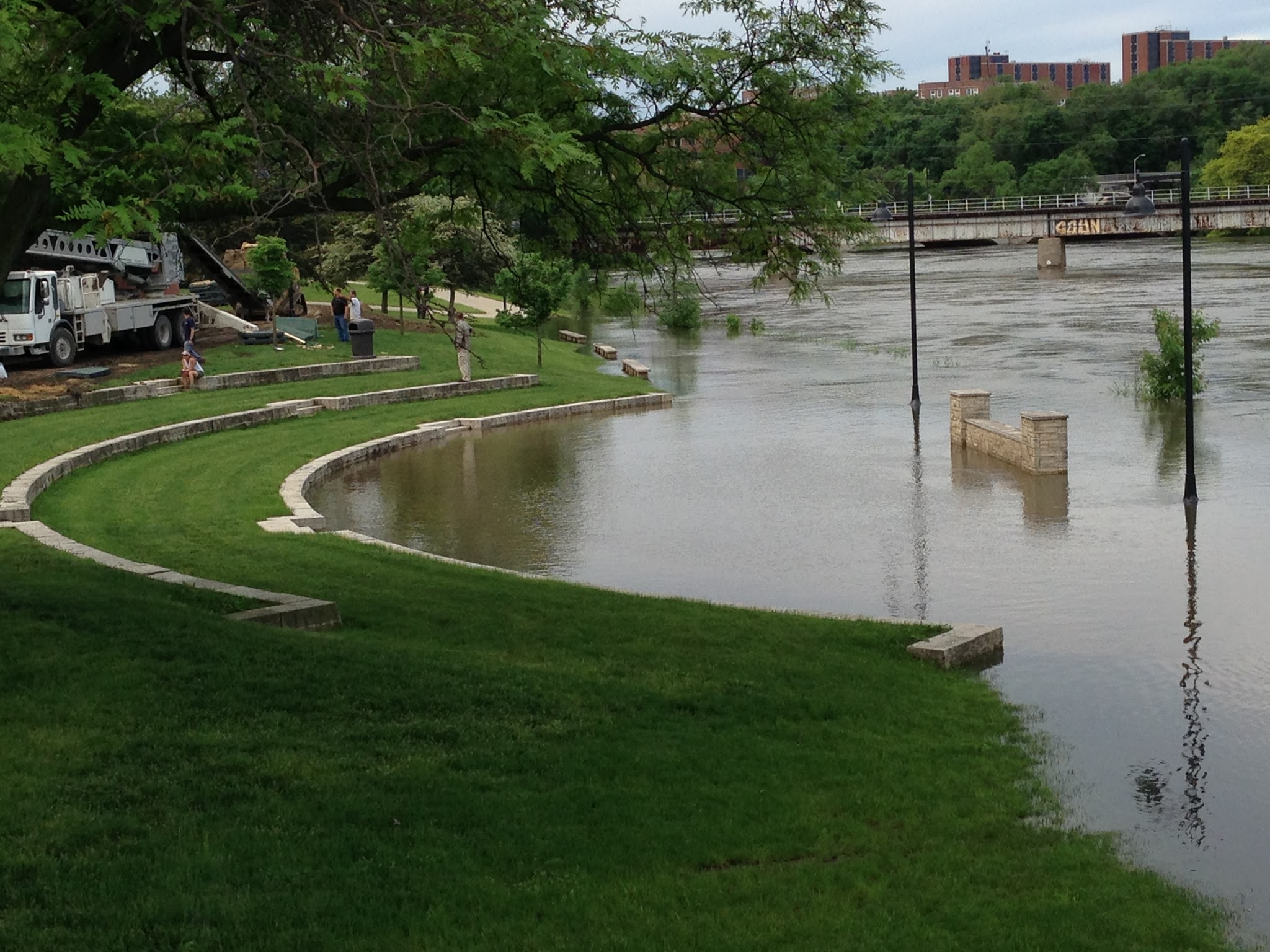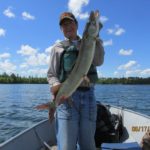If you are an educator, policymaker, journalist, or a scientist seeking partners on a project, the Iowa Water Center has a directory of water resource specialists and scientists who can provide answers to all your water resource questions.
Continue readingBringing citizens together to make a change
Post submitted by Rick Cruse, Director of the Iowa Water Center
The Citizens Water Academy meets for four four-hour educational and participatory sessions. This seems a somewhat unique approach to addressing Iowa Water Quality issues. Bringing together diverse community members in an educational environment, particularly when addressing a somewhat controversial and divisive topic, seems to stretch the comfort zone and knowledge space of those attending. One unique outcome of this approach, when complimented with an audience participatory format, takes the thought process outside ones normal beliefs or thought patterns. The process is important because we are constantly trying to find new and innovative ways of addressing water quality problems.
We are using approaches that could potentially be adopted and lead to improved water quality when implemented by a variety of interested stakeholders. In contrast, many of our traditional approaches to develop new ideas and innovated approaches involve diverse meetings populated by recognized water quality experts; different meetings organized by different conveners with a desire to develop new solutions that typically include the same water experts and produce the same ideas. These traditional approaches have not led to ideas that have achieved progress towards improved water quality. For us to make a switch in regard to water management, somebody in the system has to do something different. According to Chip Heath and Dan Heath in the book Switch, it is important to find successes already occurring. It is also critical to motivate people to grow in their mindset and shape a positive and inclusive path forward to successfully make a change.
The culmination of the Citizens Water Academy requires the participants to put on an assigned hat, that of a farmer, agency, water utility, or water recreation participant. With the perspective of the assigned ‘hat,’ each group develops policy targeting water quality. Will this ‘out-of-the-box’ approach yield water quality related policy ideas that will move us forward? We will find out at the conclusion of the Academy sessions.
There is a popular quote that states, “the definition of insanity is doing the same thing over and over again, but expecting a different result.” Doing more of what we have already done is likely to get us more of what we already have. Process is important; taking the process ‘outside the box’ may be our next and best option to improve water quality before the regulatory toolbox is unlocked.
 Rick is a professor in the Department of Agronomy at Iowa State University where he has administration, research, teaching, and extension responsibilities focusing on soil and water management; he is also Director of the Iowa Water Center. He earned his BS from Iowa State University and MS and PhD from the University of Minnesota.
Rick is a professor in the Department of Agronomy at Iowa State University where he has administration, research, teaching, and extension responsibilities focusing on soil and water management; he is also Director of the Iowa Water Center. He earned his BS from Iowa State University and MS and PhD from the University of Minnesota.
Successful Watershed Management in the Upper Midwest: Getting to Scale
Post written by Melissa Miller, Associate Director for the Iowa Water Center
On November 6 and 7, a group of about 35 stakeholders representing fields of higher education, government, policy, and watershed practitioners gathered in Dubuque, Iowa, for a working session entitled “Successful Watershed Management in the Upper Midwest: Getting to Scale.” Rebecca Power and the North Central Region Water Network organized this event. The meeting was funded by the Environmental Defense Fund and the Walton Family Foundation. Attendees from all over the region contributed, including Iowa, Minnesota, Nebraska, Wisconsin, Illinois, Indiana, Ohio, and Arkansas; other attendees came from Washington, DC, Harvard, and other nationally-based organizations.
The ultimate product of this working session will be a white paper that explores the necessary elements of watershed management as a scalable unit and the necessary elements of support that make successful watershed management possible. We started with education before conversation, first setting the stage by defining “successful watershed management” and determining what “getting to scale” really meant. A series of lightning talks followed, covering successful watershed management models and highlighting some necessary elements of those examples.
Then, the real work began. We split into small groups, facilitated by Jamie Benning (ISU Extension and Outreach Water Quality Program), Ann Lewandowski (University of Minnesota Water Resources Center), Kate Gibson (Daugherty Food for Water Institute at University of Nebraska-Lincoln), and myself. We discussed the scalable unit for watershed management – the smallest administrative unit that includes key infrastructure, relationship, architecture, and other necessary elements of our theory of change. (We mostly agreed that it’s probably a HUC-12 watershed – except we could all think of some times it isn’t.) Then we identified the “necessary elements,” categorized by human capacity (leadership and learning), social capacity, financial capacity, policy and governance, and technology. We used the same categories for determining those necessary elements that support the scalable unit. On the second day, we expanded on those necessary elements and provided evidence and examples.
There was a lot of information exchanged and ideas generated in a short period. It was exciting to participate and meet people I hadn’t previously worked with in the same space. It was inspiring to cover familiar topics with some familiar faces in a new, comprehensive way. The white paper is expected to be finalized in spring of 2018. We’ll be sure to share it when it’s ready!

Melissa Miller is the associate director of the Iowa Water Center. She earned a BS in Kinesiology from Iowa State University with an emphasis in Community and Public Health. She is currently pursuing a MS degree in Community Development with an emphasis in Natural Resource Management, also from Iowa State University.
University of Iowa: A case study of flood response
In honor of construction starting soon to replace one of the last University of Iowa buildings damaged by the 2008 floods, we have decided to highlight a history of flood infrastructure investments at the university .
Just one-year shy of a decade since the 2008 floods, the final plans have been approved for a new facility for the University of Iowa Museum of Art. Like Hancher Auditorium, the music school, the library, and the Iowa Memorial Union, among about seventeen other buildings (Connerly et al 2017), the art museum was a significant loss to the university that scattered its 14,000-estimated piece collection to new locations on and off campus.
According to Connerly et al 2017, damages and recovery were estimated to be $743 million and is the highest costing disaster recovery in Iowa. As a public institution located in a floodplain area, it has had a history of flood preparation and response since its inception in 1847. As their article explains, the flooding brought up many critical questions, including: “why did the University construct important new buildings, some of them iconic, within the floodplain?” and how can the university cope with future natural and human-made flooding?
To answer the first question, the university built where they did predominantly because they had few options. The risk of flood also gave the appearance of being manageable at the time and policies for flood mitigation and subsidies were more risky than they appeared to be (Connerly et al 2017). The university started on a small four block area east of the Iowa River. The university and the City of Iowa City grew concurrently causing buildings to be placed closer and closer to the river. In 1905, the university commissioned a master plan by the Olmsted Brothers that included riverfront property, but its use would only be for recreation and parks (Connerly et al 2017). Land acquisition advisement by the Olmsteds was illustrated in the following:
“The Olmsted Brothers emphasized the need to acquire land that would be of value to the University, even if it costs more. They stated, ‘‘the process of acquisition of additional land must evidently go on indefinitely, but some other motives than those of convenience and cheapness should be kept in mind and should often have more weight than those.” (55)
The construction on the floodplain started with the Iowa Memorial Union (IMU) in the 1920s and then grew to include the arts campus. Construction for a fine arts building was originally planned for a site north of the IMU, but an agreement could not be reached for a price. Instead, the campus was developed on acquired land that was a wetland formerly used as a city landfill by the river (Connerly et al 2017).
The wetlands were filled and the buildings were constructed to be above recorded flood level data available at the time and levees were constructed on the river. Later, these efforts included the university’s support of building the Coralville Reservoir by the Army Corps of Engineers, in which the president of the university at that time stated, “the Reservoir will make possible a program for the permanent development of the river front through the University campus” ( Connerly et al 2017, p.58). The campus was growing in two halves on the east and west side of the river. Development in-between would unite the two pieces, especially when considering there were little other places to build.
This culminates in the issue of what Connerly et al (2017) describes as the “safe development paradox.” This term is used to describe the federal support for levees, dams, disaster aid programs, and other assistance that spurred development in the floodplains. By providing a safety net with federal assisted water-related control, recovery, and insurance, federal policy enabled development that came at a cost with the 1993 and 2008 floods.
How can the university cope with natural and human-made flooding for the future?
To answer this question, the university has responded to the 2008 floods by re-purposing or completely rebuilding new facilities that are more resilient to withstanding future flooding using scientific modelling as a tool. The recovery efforts include a multitude of partnerships that choreograph their work around where FEMA compliance and insurance policies reach within each building. The university voluntarily chose to conduct a campus-wide flood mitigation strategy that is in progress. This strategy includes elevated sidewalks, supports for temporary flood walls, building pumping systems, and removable external walls. The university has also rebuilt two buildings away from their original locations. As seen above, these strategies have been tested with the rise in water levels in 2013.
In review, the tumultuous history of flooding infrastructure contains valuable lessons. Resilience, which is at the core of what public infrastructure is trying to achieve, is the ability to spring back from disasters. The university that came out on the other side of the 2008 floods is one that utilizes water research and technology using scientific methods and demonstrates that there is room for improvement in state and federal policies and procedures. As a result, when future flooding occurs, we will all be better able to respond.
Connerly, Charles, Laurian, Lucie, Throgmorton, James. 2017. Planning for Floods at the University of Iowa. Journal of Planning History 16(1): 50-73.
Hanna Bates is the Program Assistant at the Iowa Water Center. She has a MS in Sociology and Sustainable Agriculture from Iowa State University. She is also an alumna of the University of Iowa for her undergraduate degree.
Planning for Watershed Success in Eastern Iowa

Post edited by Hanna Bates, Program Assistant at the Iowa Water Center
This week, we chatted with Jennifer Fencl, the Solid Waste & Environmental Services Director at The East Central Iowa Council of Governments (ECICOG). Fencl works to bring eastern Iowa stakeholders together to better manage their natural resources and to create a long-term investment in their community. Below are a few highlights from our conversation that outlines some of the behind-the-scenes work in watershed planning.
Please describe your work in watershed management in Iowa.
The East Central Iowa Council of Governments (ECICOG) became involved in watershed management in 2011 when the City of Marion requested assistance in applying for Watershed Management Authority Formation grant funding from the Iowa Economic Development Authority (IEDA) for the Indian Creek watershed. The Indian Creek Watershed Management Authority (ICWMA) was formed under Iowa Code 28E and 466B in August 2012 with 6 of the 7 eligible jurisdictions agreeing to plan for improvements on a watershed level. Funds were made available in 2013 by the IEDA to complete watershed management plans to address flood risk mitigation and water quality. The ICWMA received one of the three planning grants and engaged in a multi-jurisdictional planning approach facilitated by ECICOG in partnership with several local, state, and federal agencies. The resulting Indian Creek Watershed Management Plan (ICWM Plan) identifies strategies and recommendations for stormwater management and water quality protection, including specific implementation activities and milestones. The ICWM Plan was completed and presented to the public in June 2015 and adopted by all six of the ICWMA members at policy maker meetings during July and August of 2015.
As the ICWMA Plan was wrapping up, the City of Coralville requested ECICOG’s assistance in forming a WMA for the Clear Creek watershed. In this case, Coralville was willing to sponsor the WMA formation and planning grant application services. The Clear Creek Watershed Coalition (CCWC) formed as a WMA under Iowa Code 28E and 466B in October 2015 with all 9 of the eligible jurisdictions joining. ECICOG secured DNR watershed planning funds early in 2016 and the CCWC is mid-way through their planning process. Fortunately, the Clear Creek watershed was one of the eight watersheds selected for the Iowa Watershed Approach HUD grant project. The additional watershed planning funds from the HUD grant will add significantly to the resulting watershed plan.
In early 2016, the Middle Cedar Watershed Management Authority (MCWMA) was on its way to formally becoming a WMA and needed some help in completing the agreement filing, developing by-laws, and organizing the Board of Directors. ECICOG assisted the MCWMA in forming under Iowa Code 28E and 466B in June 2016 with 25 of the 65 eligible jurisdictions joining. The MCWMA is one of the eight watersheds selected for the Iowa Watershed Approach HUD grant project.
What are the challenges and rewards in doing work with watershed management?
One challenge that became clear in the Indian Creek process was the disconnect between the watershed (technical) assessment and the local stakeholders. That gap must be bridged to develop meaningful, locally-based goals and implementation strategies. For me, the reward is watching the interaction between perceived “enemies” (urban/rural; big city/suburb; ag producer/government type) and bringing skeptical people into the process to develop an actual plan… that they ultimately agree to.
What kinds of stakeholders are involved in developing a watershed management plan?
It is critical to include the local Soil and Water Conservation District, government representatives, and the landowners (both urban & rural, flood impacted if possible) in developing goals and strategies. I believe that it is also important to identify the ‘experts’ in your watershed, both locally and from state agencies, early on and have them provide input on what assessment activities and planning services are really needed from an outside consultant. There is a role for everyone to play.
What are the basic steps in putting together a watershed management plan?
Here is my road map:
- Invite participation
- Identify resource concerns
- Assemble experts
- Complete assessment work
- Present the assessment to a broad list of stakeholders (need good interpreters)
- Develop goals, define implementation strategies, and prioritize the strategies
- Compile the plan and present the plan for comment
- Shop the plan for formal adoption by policy making board/councils.
What is one piece of advice you’d give to those wanting to develop a watershed plan for their community?
Run… kidding, sorta. Seek help from the Iowa Department of Natural Resources and Iowa Department of Agriculture and Land Stewardship basin coordinators first, and then gauge the interest of the other entities in the watershed. You need to find some champions to help smooth the way for local elected officials.
Breaking down the Waters of the US
Submitted by Solomon Worlds, Iowa Water Center Science Communication Intern
Note: This post, and the referenced Riessen article, was written prior to the release of the Executive Order issues on WOTUS. The EO can be found here.
Hello Readership,
Recently, there has been a great deal of commotion around a recurring Supreme Court case that has yet to be ruled on. This legal battle is just another in the long line of battles over a famous piece of legislation we know as the Clean Water Act (CWA). This most recent battle is over the “Waters of the US rule” (WOTUS) definition that was made by the EPA and Army Corps of Engineers in June of 2015. Immediately after the decision was made, many legislators and officials (including our Iowa governor and two federal senators) voiced their opposition.
Some say that the federal government is overstepping their bounds. They say the federal government does not have jurisdiction over some of the WOTUS and that the June 2015 definition is either too broad or too vague. However, is there real constitutional precedent to halt the federal government’s involvement? What is actually in the CWA? Since this fight has made it to back the Supreme Court, what is different? And, what were the decisions of previous hearings? What will be the outcome of this rendition?
Jack Riessen, P.E., retired Iowa Department of Natural Resources employee and former advisory board member for the Iowa Water Center, wrote a short informative report in January 2017 that answers all of my above questions and probably a few others that you may have thought of. His well-written article carefully gives a brief history of the CWA fight by outlining the events of the past that have gotten us to where we are now. This enlightening review is written to appeal to those who do and those who do not know a lot about water, making it accessible for everyone. Click here to read Riessen’s full piece.
Flow forward my friends,
Solomon Furious Worlds
P.S.: In my first post, I promised more information on my name. My father wanted my middle name to start with an “F.” It was almost “Francis,” but there was a character from a popular 1991 film featured a character whose name was “Jason ‘Furious’ Styles.”





